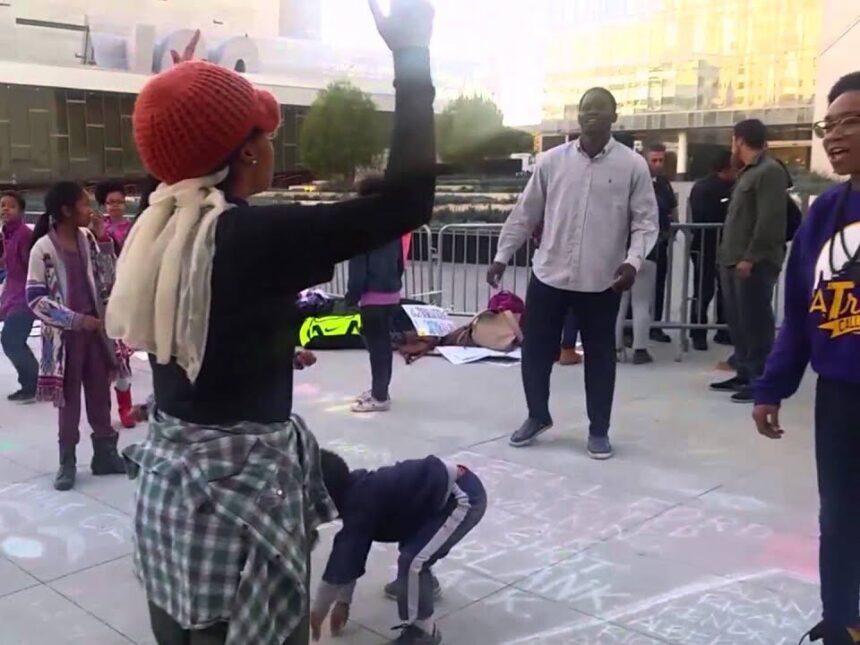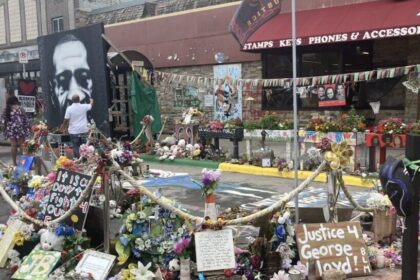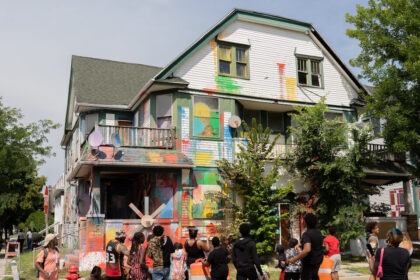Interview with Dr. Shamell Bell
Laura Thompson
Dr. Shamell Bell is a mother, community organizer, dancer/choreographer, and documentary filmmaker who received her PhD in Culture and Performance from UCLA’s World Arts and Cultures/Dance department. Dr. Bell is currently a visiting faculty at Dartmouth teaching in the department of Theater and the African and African American Studies program. Bell received her M.A. in Ethnic Studies from UC San Diego and B.A. with Honors in American Studies and Ethnicity specializing in African American Studies at the University of Southern California. Her work on what she calls, “street dance activism” situates street dance as grassroots political action from her perspectives as a dancer, choreographer, healer, and scholar. Her research examines street dance movements in South Central Los Angeles through an ethnographic and performance studies lens. The interview was conducted in the Fall of 2021 between Dr. Bell and Laura Thompson. The discussion sheds light on Bell’s background, her past and present artistic production, and role as an activist, scholar, and artist.
Laura Thompson: You are a community organizer, a dancer, a choreographer, a scholar, and a documentary filmmaker. When you were younger, what did you hope to become and at what point was it clear that this would be your path?
Shamell Bell: I started at two years old in entertainment. My mother was incredibly talented. She was in the urban fashion scene, and she actually trained models at these places that they now call scam modeling places, like Barbizon or John Robert Powers. They like get a whole bunch of people who will never really be runway models and teach them how to do it. I don’t know if you’ve ever heard of them, but my mother was a teacher there and she decided that she wanted to do it for kids that were Black and Brown. She was doing most of the training when at that time Barbizon was made up of mostly white instructors. My mother trained in a lot of different ways. She created terminology and vocabulary, and I was helping her. At the time, I was doing beauty pageants from the age of two to maybe ten. I’m sure that initially I wanted to do it like my mother or at least to make my mother happy, but it began to be crazy…I never wanted to be a star, but I would always get first place. And it just got to a point where even before I knew I won, I was like, can they mail the trophy home? But I wasn’t being arrogant. It was just how it was…
At the time, my mother was doing modeling in the inner city. And I, with my friends or people I found on the street, got involved in the performing arts community in South Central Los Angeles or the Inglewood area. We auditioned for music videos, I interned for different music videos, and then I would write my friends into them. That’s how we got discovered on the set of Christina Aguilera’s “Dirrty” for David LaChapelle’s documentary Rize (2005). So, from that point, it became clear that I could have been a professional dancer. I mean, I was a professional dancer, but it was more part-time and more like I’m a street dancer. And then, we’re in these environments where it’s cool to document urban kids. Somehow, I became the Krumper in the Will Smith video or the Blue Man Group commercial… Then, I went back to college, and I would dance part-time and that’s how I knew that I didn’t want to professionally dance. Instead, I wanted to dance for a purpose and so I didn’t pick it back up until the Black Lives Matter movement. I would street dance for the community, but I didn’t know I would become a core leader of an international group. I was just feeling all the pain and grief and sorrow while we were occupying space at the LAPD headquarters. And I had a thought: I’m a dancer. I know how to gather people in the community with dance. That’s something that I had done in the parks since I was younger. So, I started a class there and called it Street Dance Activism and here we are today.
LT: Did street dance activism emerged explicitly out of your engagement with Black Lives Matter and your role in organizing?
SB: All of my different ways of being intertwined at the same time. I was in college while, I had a subset of folks called Teens with No Color Lines. We were all different races and we would come together, and even back then I would make sure that folks had good grades and were going to colleges. Even though we were from South Central we went to UC Berkeley, UCLA, and USC. I was in a class with Robin D.G. Kelley, who wrote this amazing book called Freedom Dreams (2002). One day in class, someone was doing a presentation on Krump and I saw myself in the trailer they were showing, which made me visibly uncomfortable. Afterward, people were asking “Is that you?” And I’m just like, “yeah…” So, at that point Robin D.G. Kelley suggested that I become a scholar of my own folks. I think the importance of it was to study street dance as our lived experience, from an autoethnographic point of view.
At the same time, I was in a class with Melina Abdullah, who is a core leader and founder for Black Lives Matter Los Angeles. For the midterm, she asked us to do some community organizing, so I interned at the Obama campaign. I was able to understand that I wanted to do something with community. I wanted to organize. I wanted to dance. Later, I reconnected with Melina Abdullah again. She was the first person I called after the Zimmerman verdict and I wailed to her like he was my own son because I was a brand new mom. And then we got out onto the streets with our children. So that’s a full circle moment. I was studying Krump and then I began to become a scholar of street dance. At the same time, I’m learning my vision for community organizing from Melina Abdullah. Later, Robin Kelley was my PhD program advisor at UCLA and I was doing Black Lives Matter work with Melina Abdullah. So it has been a synchronistic and serendipitous journey for me where it’s just a moment of being present. And I’m always saying yes to what makes me feel congruent. For me, when I got into my PhD program at UCLA in World Arts and Cultures/Dance, I came in studying street dance as I had been doing since 2009. But then Black Lives Matter emerged as an international phenomenon and I decided to bring my street dance into the Black Lives Matter movement. My work is auto-ethnographic. It has always been work about documenting our own stories and being able to tell our own stories.
LT: Thank you for sharing this history. I am particularly interested in how you are positioning street dance activisms and workshops adjacent to state institutions like an LA police station, for example. Could you talk about the importance of location in this aspect of your practice? Is it a form of entering into a dialogue in a way? Or presenting a forum to respond to actions perpetrated by those institutions?
SB: Yeah, so definitely a civil disobedience, right? It was a spatial disruption, a spatial intervention. We were there for about eighteen days. We were requesting to get the autopsy report for who was shot in the back. The autopsy report showed that there was a muzzle imprint so he couldn’t have been running away or something like that. We weren’t on the street, but the sidewalk. They decided to put gates up and then when we started dancing they started to zip tie the gates. We had already been somewhat harassed by them. They would get rid of our truck every morning or were making us get rid of our tents and all of these types of things. But it was something really profound. We always document things on our phones. [1] You know, when I was in the PhD program, my advisors said you should do this as a project. So anytime I would read something in a class, I would theorize it alongside what my lived experience was. I have these beautiful life projects and small documentaries, where I do something creative like direct or put together dancers—like the Krump men—and think about what it means to the movement. Then I would show behind the scenes footage of us doing street dance activism. For me that was bringing what was going on in the streets into the Academy. It was a theoretical, strategic, and spatial intervention, but most importantly, it was a spiritual intervention, which was significant for me as someone who identifies as an empath, as someone who understands the world through my senses.
LT: You’ve described street dance activism as kind of corporeal pedagogy and as “choreographies of the liberated.” How does this intersect with your Black Lives Matter advocacy and your work in and with social justice organizations? Furthermore, how did your advocacy work during COVID?
SB: Basically, I had this dream. I saw people dancing all over the world together. At first, it was with all this heaviness because it was right after George Floyd, and when you’re having a pandemic and an uprising, there was so much heaviness in my body. But in this dream, I saw people dancing and then there was a shift where everyone … had some kind of spiritual component. It was even embedded in the music. When people moved to the left all of a sudden I felt a quantum leap, like all at once everything felt so much lighter. It felt like we ushered in some kind of new dream…It was so beautiful that I started to cry in my dream. When I woke up, I still had tears on my face. I freaked out and I described the dream on Facebook. Then everyone started going under the post, saying that they wanted to do it, so then we started meeting… And that was the start of the [global dance meditation for Black liberation] practice. So, I wondered what the best way for us was to get light enough for that shift, to get rid of all of the things that are blocking us and to get light enough for the quantum leap. So…that looked like working on self-compassion, working on forgiveness, working on self-love, working on all of these things to get us freer internally. After [doing] this process together, we would integrate at 11:11 in the morning…on Instagram Live. And we would discuss things of the day. We had a mantra of the week. The first week, I remember off the top of my head, was “I am and that is more than enough.” And with that we would say it together. After that, at night, a couple of us would talk about how difficult it was to get through the week, but then we would have incredible people like [the choreographer] Marlies Yearby—who did Rent—come in to do a masterclass for one of our integrations with breath and the body. Then we had conversations with Rennie Harris, who is a great original street dancer. We also [facilitated a conversation between] Dianne McIntyre—an extraordinary, brilliant African American woman choreographer—and Marlies [Yearby]. We had powerhouses there. And then we got through our twenty-eight days [in August] and we had this huge culminating moment that coincided with the movement for Black Lives’ Black National Convention… [2] That is exactly how [street dance activism] was digital and how we are still digital and still helping each other enjoy life…Later, this coffee company in Italy named Lavazza found me on the internet. [3] I told them that they couldn’t just have me. That they had to bring other street dance activism folks with me and they got some of them in the shots but, that was just setting the precedent of how we want to move through the world together.
LT: Lastly, where do you think activist art and performance are heading? Or where would you like it to head in your own work?
SB: I’m heading into everyday lived experience as choreography. You know, when we talk about co-creation, everything is choreography and we’re trying to put together this dance piece of liberation. If you dance through life, you think about it like a metaphor, like, be like water, right? We flow but think of it as a dance. We dance with life and it’s a sacred dance. So, I’m hoping that’s where there’s no separation between the dance of life and the depth of existing. What we don’t want in life anymore, like this move towards what we want to dismantle and destroy, but there is a way in which we don’t have to focus so much on what we’re lacking, but rather dance towards the future. We already know it to be true because we feel it in our bodies as dancers and choreographers.
LT: Dr. Shamell Bell, thank you so much for taking to time to chat about your work.
Laura Thompson is a Ph.D. student in Art History, Theory, and Criticism at the University of California, San Diego and a member of FIELD’s editorial collective.
Notes:
[1] Shamell Bell, “Living is Resisting: Street Dance Activism in Black Lives Matter,” YouTube (March 7, 2015), https://www.youtube.com/watch?v=tDeFXrzDyu8.
[2] The 28-day devotion in August is reference to Black August. According to the Movement for Black Lives website, “Black August is an acknowledgment and commemoration of the countless organizers, activists, and freedom fighters who sacrificed their freedom and lives in the struggle for Black liberation. Black August takes place during the month of August, and was started in California prisons in the 1970s by Black freedom fighters who wanted to honor the lives and deaths of Black political prisoners killed by the state, bring awareness to prison conditions, and to honor the radical tradition of Black resistance against anti-Black state violence and systemic oppression.” See The Movement for Black Lives, “Black August” M4BL, https://m4bl.org/black-august/.
[3] At the 2022 Basel Miami, Lavazza Calendario presented “I Can Change the World,” an event that highlighted six activists’ stories as told through the lens of photographer and cinematographer Emmanuel Lubezk. Each of the selected activist works with art or music with the intent of changing the world. Bell was selected along with Ben Harper, Sonita Alizada, Cristina Mittermeier, Shilpa Yarlagadda, and Saype. See https://calendar.lavazza.com/calendar-2022/index.html











